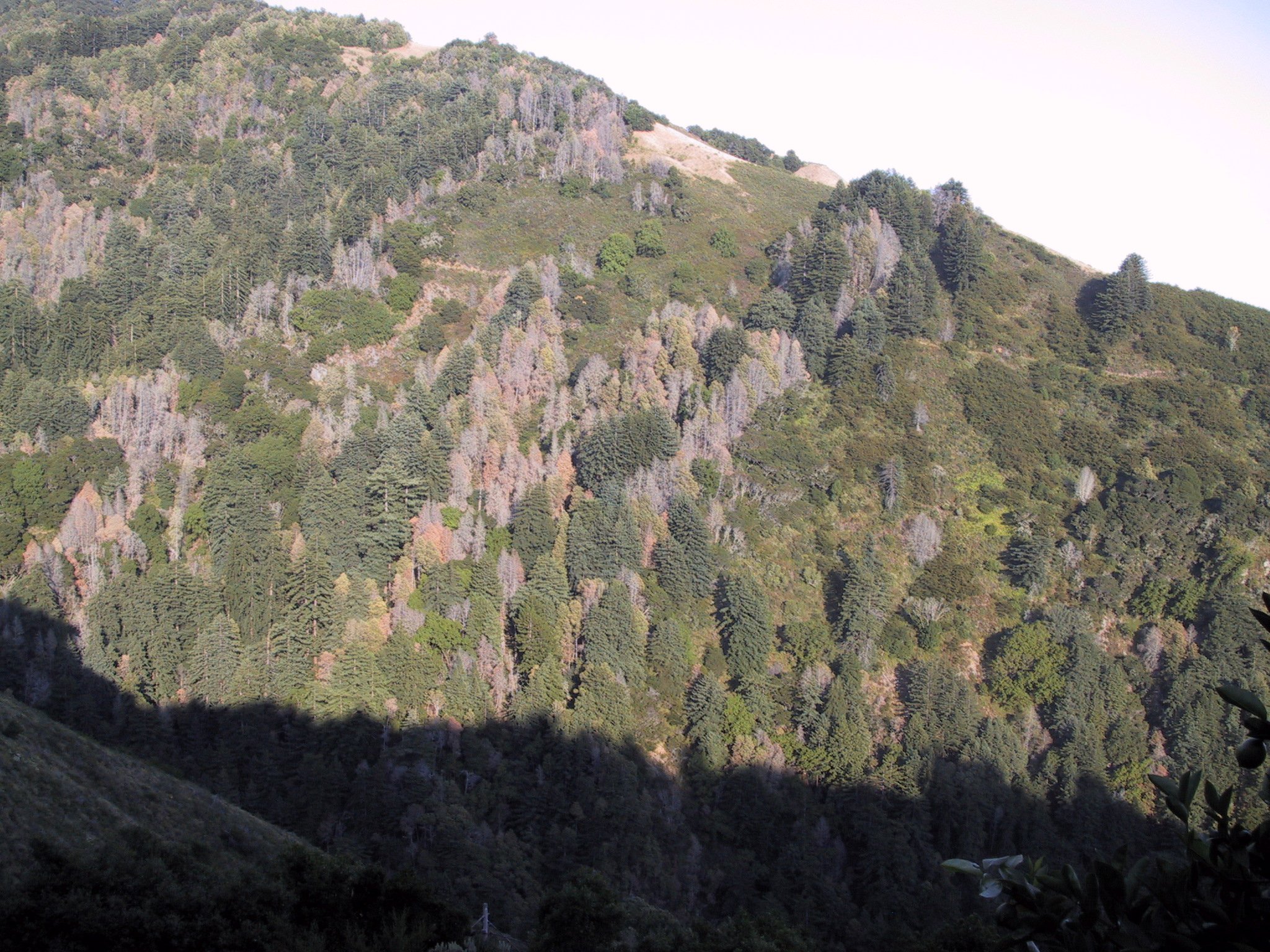The Deadly Disease No One Talks About: Sudden Oak Death
By Sylvie May, WellKind Forestry Intern
Sylvie May was an intern for WellKind Forestry during our summer 2022 session, exploring tree diseases and other environmental topics.
Source: Wikimedia.
In the past decade, around 1 million oak and tan oak trees have been killed by Phytophthora ramorum – a pathogen just as scary as it sounds. Phytophthora ramorumm is responsible for sudden oak death, which is causing trees to break out in cankers that quite literally bleed sap. The pathogen infects trees through their oaks and causes them to rot from the inside out. This horrible disease is killing tanoak, coast live oak, shreve oak, and California Black oak from Humboldt county to Monterey county and some areas in Oregon.
Sudden oak death was first discovered in Marin County in 1995 and has since had devastating effects on the oaks and tan oaks in California..A key way sudden oak death spreads is through spores on foliar hosts, primarily in wet climates. The pathogen is able to infect 107 species but only kills certain oaks. The susceptible plants that do not die when infected help the pathogen spread. When P. ramorum infects bay laurel trees, it produces more spores compared to other plants, making them exceptionally dangerous to oak trees when nearby them (Nahigyan, 2016).
preventing sudden oak death
The leaf of an oak infected with P. ramorumm. Source: Wikimedia.
Cankers caused by Sudden Oak Death. Source: Wikimedia.
Currently, there is no single cure for the deadly disease, but there are several ways in which you can prevent sudden oak death from reaching your beloved forest. The first is to thoroughly clean off shoes and equipment after going through infected areas. It is also pertinent that you do not move any plant parts from infected to uninfected areas, including firewood. The telltale signs that a grove is infected is if several oak trees are dead, there are cankers on the branches and trunks, and “bleeding” cankers are present. It can also be spread through plants bought at nurseries, so be careful to select ones that don’t have leaf spots or off-color leaves (Lee, Valachovic, and Garbelotto, 2010).
Once a tree is infected, there is next to nothing you can do from slowing the tree death or preserving the tree's life. This makes it exceptionally important to slow the spread of the disease by being extremely cautious and aware when in a an area infected with sudden oak death. It is very difficult to contain the invasive disease in forest terrain which is why it is very important to foster good forest and tree health in these areas (Lee, Valachovic, and Garbelotto, 2010).
Presently, the only auspicious technique for treatment for an individual oak tree is phosphate control. Phosphate has fungicidal properties, allowing it to stimulate the tree's protection against the disease. It protects the tree from sudden oak death if applied before infection or can help enhance the tree's lifespan once infected. However, it can be tricky to apply the treatment, and currently it can’t be done to a mass number of trees (Lee, Valachovic, and Garbelotto, 2010).
Not only does Sudden Oak Death have a large impact on forests, but it affects people as well. Oak trees sequester the most carbon out of any other trees, meaning they have a huge impact on reducing greenhouse gasses in our atmosphere. With millions of oak trees dying, there are fewer and fewer trees helping to combat climate change. In addition, dead oak trees make for great kindling during wildfires. Garbelletto and David Rizzo, both professors at UC Davis who discovered the pathogen causing sudden oak death, said, “Infected oaks are a fire hazard and pose risk to infrastructure if they fall.” This lethal pathogen has the potential to destroy California's coastal forest ecosystems and should not be overlooked (Fimrite, 2019).
REFERENCES
Fimrite, P. (2019, November 7). Sudden oak death spreading fast, California's coastal forests facing devastation. San Francisco Chronicle. Retrieved August 1, 2022, from https://www.sfchronicle.com/environment/article/Sudden-oak-death-spreading-fast-California-s-14815683.php
Lee, Valachovic, and Garbelotto. (2010). Protecting trees from sudden oak death before infection. University of California Agriculture and Natural Resources. Retrieved August 2, 2022, from https://nature.berkeley.edu/garbelotto/downloads/8426_SOD.pdf
Nahigyan, P. California oaks are dying, and there's nothing we can do about it. Planet Experts. (2016, May 19). Retrieved August 1, 2022, from http://www.planetexperts.com/california-oaks-dying-theres-nothing-can/
Sudden Oak Death. Home. Sudden Oak Death. (2022, May 31). Retrieved August 1, 2022, from https://www.suddenoakdeath.org/
University of California Agriculture and Natural Resources. How to manage pests. UC IPM Online. (n.d.). Retrieved August 1, 2022, from http://ipm.ucanr.edu/PMG/PESTNOTES/pn74151.html



